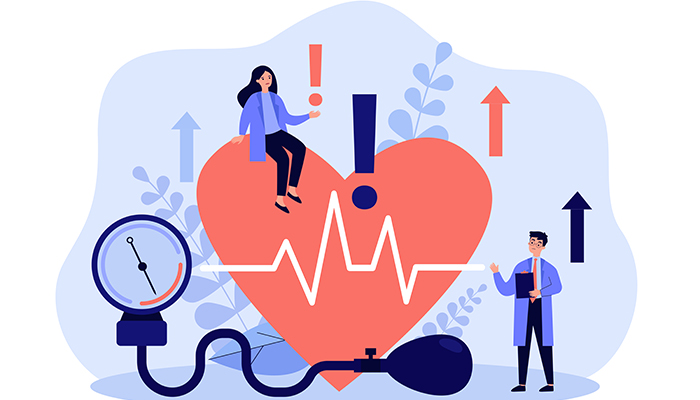Cardiology Jupiter’s expert tips for reducing cholesterol naturally
Cardiology Jupiter’s expert tips for reducing cholesterol naturally
Blog Article
Comprehending the Value of Cardiology in Modern Medical Care Providers
Cardiology plays a critical role in modern healthcare, particularly as heart illness remains to be the leading reason for mortality worldwide. Advancements in diagnostics and treatment have transformed patient treatment, making it possible for earlier treatments and boosted end results. In addition, the change in the direction of precautionary cardiology equips individuals to manage their health proactively. As modern technology remains to progress, the combination of innovative solutions might additionally redefine cardiology's effect on public health and wellness, prompting a more detailed exam of arising trends and their implications.
The Frequency of Cardiovascular Disease and Its Impact on Public Health
Although cardiovascular disease stays the leading cause of fatality internationally, its impact expands much beyond specific clients to affect public wellness systems and economic climates. The high frequency of heart illness places a considerable strain on medical care resources, necessitating raised funding for treatment, avoidance, and rehabilitation programs. Public wellness efforts have to deal with threat factors such as weight problems, smoking, and inactive way of lives, which contribute considerably to the rising occurrence of heart conditions.Moreover, the economic worry connected with heart disease is enormous, incorporating not only direct clinical prices yet also indirect costs connected to shed productivity and premature mortality. Neighborhoods encounter challenges in managing these costs, commonly leading to disparities in health care gain access to and results. As the populace ages and lifestyle-related threats proceed to rise, the urgency for effective cardiology interventions ends up being vital. Subsequently, resolving cardiovascular disease is not only a matter of individual health but also a crucial public health priority.
Developments in Cardiac Diagnostics and Imaging Techniques
Recent developments in cardiac diagnostics and imaging strategies have actually reinvented the field of cardiology, enhancing the ability to check and identify cardiovascular disease. Methods such as cardiac MRI, CT angiography, and echocardiography have actually come to be progressively sophisticated, providing thorough pictures of cardiac frameworks and features. These modalities permit for the very early identification of problems like coronary artery illness, cardiac arrest, and valvular disorders.Moreover, innovations in non-invasive diagnostics, such as wearable innovation and remote monitoring gadgets, have equipped individuals and health care suppliers. These tools facilitate real-time monitoring of heart rhythms and other crucial indications, causing timely treatments. Additionally, expert system is being incorporated into imaging evaluation, enhancing precision and effectiveness in medical diagnosis.
Developments in Therapy Choices for Heart Issues
Recent improvements in cardiology have caused substantial developments in therapy options for heart problems. These consist of advanced medical techniques that improve step-by-step outcomes and emerging medicines that supply new opportunities for treatment. As the field progresses, these technologies play an important function in boosting patient care and results.
Advanced Surgical Techniques
Technologies in surgical methods have actually changed the landscape of cardiology, supplying new hope for individuals with heart disease. Minimally intrusive treatments, such as catheter-based interventions, have considerably minimized recuperation times and hospital stays. Methods like robotic-assisted surgical treatment boost accuracy, permitting surgeons to navigate complex anatomical structures with greater accuracy. Furthermore, developments in imaging innovation assist in real-time visualization during procedures, enhancing results. Transcatheter aortic shutoff substitute (TAVR) exhibits a breakthrough in treating aortic constriction, making it possible for shutoff replacement without open-heart surgical treatment. Additionally, hybrid approaches that integrate catheter-based and medical methods provide tailored options for various heart problems. These advanced surgical strategies not only enhance client safety yet likewise broaden therapy options, underscoring the essential function of advancement in modern cardiology techniques.
Emerging Drugs and Treatments
As the landscape of cardiology proceeds to develop, emerging drugs and therapies play a critical duty in improving treatment alternatives for heart disease. Innovations such as unique anticoagulants and advanced lipid-lowering representatives have changed the administration of heart diseases, greatly minimizing client morbidity and death. Furthermore, the growth of gene treatments and regenerative medicine uses promising methods for treating conditions formerly deemed incurable. Medical tests are continually exposing the efficacy of these therapies, pressing the boundaries of standard therapies. The combination of electronic wellness technologies helps with individualized medication, allowing for tailored treatment plans based on hereditary and way of living variables. Collectively, these developments highlight the vibrant nature of cardiology, boosting person outcomes and redefining standards of care in contemporary health care.
The Function of Preventive Cardiology in Individual Treatment
Preventative cardiology plays an essential role in client care by concentrating on the identification of risk elements that add to cardiovascular disease. Via lifestyle alteration methods and very early discovery techniques, medical care suppliers can successfully lower the occurrence of cardio occasions - Cardiology. This aggressive technique not just enhances client outcomes but also advertises long-lasting health and wellness
Danger Element Identification
While cardio illness stay a leading reason for morbidity and mortality worldwide, efficient risk element identification serves as a cornerstone of preventive cardiology. Recognizing threat aspects such as high blood pressure, diabetes mellitus, hyperlipidemia, and family members history is important for very early intervention. Medical care experts utilize numerous screening approaches to assess these factors, enabling tailored safety nets. In addition, understanding a person's lifestyle selections, such as smoking and physical lack of exercise, even more educates risk evaluations. This thorough examination enables clinicians to create customized treatment plans focused on mitigating threats. By prioritizing danger aspect identification, health care systems can improve patient outcomes and minimize the total concern of heart diseases, ultimately adding to enhanced public wellness strategies and resource allowance.
Way Of Living Modification Techniques
A wide variety of researches highlights the critical function of way of life adjustment approaches in reducing cardiovascular disease danger. These methods include nutritional adjustments, raised exercise, cigarette smoking cessation, and weight monitoring. By taking on a heart-healthy diet regimen abundant in fruits, veggies, entire grains, and lean healthy proteins, people can reduce cholesterol degrees and high blood pressure. Routine physical activity enhances the heart and improves overall cardio health. Furthermore, stopping cigarette smoking substantially reduces the risk of heart problem and boosts recovery rates for those with status quo. Weight monitoring better adds to cardiovascular health and wellness by reducing other risk factors such as diabetic issues and hypertension. Carrying out these way of life transforms not only promotes private health but additionally acts as a foundation of preventative cardiology in patient care.
Early Detection Strategies
Lifestyle adjustments greatly add to decreasing cardio disease risks, but they are most effective when coupled with very early discovery strategies. Precautionary cardiology highlights the importance of recognizing prospective heart concerns before they rise into significant problems. Techniques such as blood pressure tracking, cholesterol testing, and advanced imaging modern technologies like echocardiograms play essential roles in assessing cardio health and wellness. Biomarkers and hereditary screening additionally enhance the accuracy of early detection, permitting tailored preventative methods. Normal cardiac risk examinations equip health care carriers to step in proactively, possibly stopping heart attacks and strokes (Cardiology). By integrating these very early detection approaches into routine care, patients can benefit from timely way of living interventions and targeted treatments, ultimately boosting and enhancing results lifestyle
Integrating Innovation Into Cardiology Practices
As advancements in innovation continue to improve numerous fields, the assimilation of ingenious devices and systems into cardiology techniques has come to be crucial for boosting individual care and end results. Telemedicine platforms allow cardiologists to monitor patients from another location, improving accessibility to care while decreasing the problem on medical care centers. Wearable tools, such as smartwatches, make it possible click for source for continuous heart rate monitoring, notifying both doctors and individuals to possible issues in real-time. In addition, expert system (AI) is being utilized to analyze large quantities of cardiac information, assisting in very early medical diagnosis and tailored therapy plans. Advanced imaging methods, consisting of 3D echocardiography, improve visualization of heart structures, causing more exact treatments. Electronic health documents (EHRs) streamline person details administration, guaranteeing that cardiologists have immediate access to crucial data. With each other, these technological improvements are transforming cardiology, advertising positive management and boosted health and wellness results for people with cardio conditions.
The Relevance of Patient Education And Learning and Engagement
Client education and interaction play an essential you could look here role in the management of cardio wellness. By equipping clients with expertise concerning their conditions, therapy options, and way of living adjustments, doctor empower people to take an active function in their treatment. This positive strategy can lead to enhanced adherence to suggested drugs, dietary changes, and exercise routines, ultimately lowering the threat of complications.Engagement additionally fosters a strong patient-provider partnership, motivating open communication and trust. When people feel notified and included, they are a lot more most likely to voice worries and ask concerns, which can result in better professional end results. Furthermore, educational resources, such as workshops or digital platforms, can improve understanding and promote self-management methods. In general, prioritizing person education and interaction is important for boosting cardio wellness, improving lifestyle, and reducing health care prices related to heart diseases.
Future Trends in Cardiology and Their Possible Impact

Regularly Asked Concerns
What Way Of Life Modifications Can Decrease Cardiovascular Disease Danger?
The present try this out inquiry addresses way of life adjustments that can substantially minimize heart disease threat. Cardiologist near me. Embracing a balanced diet, participating in regular exercise, maintaining a healthy weight, taking care of stress and anxiety, and preventing tobacco can significantly enhance cardiovascular health
Just How Can I Recognize Very Early Indicators of Heart Problems?
Acknowledging very early signs of heart troubles involves surveillance signs such as breast discomfort, shortness of breath, fatigue, and irregular heart beat. Timely recognition of these signs can prompt necessary medical evaluation and treatment for much better end results.
What Are the Differences Between Cardiologists and Heart Surgeons?
The distinctions in between cardiologists and cardiac cosmetic surgeons hinge on their duties; cardiologists mostly manage and diagnose heart conditions via non-invasive methods, while heart doctors carry out surgeries to remedy architectural heart problems. Each plays an essential, distinct function.

Exactly how Usually Should I Obtain My Heart Health And Wellness Checked?
The regularity of heart medical examination varies based on specific danger aspects. Typically, adults must go through analyses every one to 2 years, while those with present conditions might require even more regular assessments as advised by medical care professionals.
What Role Does Genetics Play in Heart Problem Threat?
Genes considerably influences heart condition danger, with domestic patterns indicating inherited problems. Certain genes can incline individuals to hypertension, cholesterol problems, and various other cardio problems, highlighting the significance of hereditary screening in evaluating heart health. Heart disease remains the leading reason of death worldwide, its effect prolongs far beyond individual patients to influence public health and wellness systems and economic situations. Public wellness efforts must address risk aspects such as weight problems, smoking cigarettes, and inactive lifestyles, which add considerably to the rising occurrence of heart conditions.Moreover, the economic concern linked with heart illness is tremendous, including not just straight clinical costs but also indirect expenses related to lost efficiency and early mortality. Preventive cardiology plays a crucial role in person treatment by concentrating on the recognition of risk aspects that add to heart disease. Man-made knowledge (AI) and maker learning are enhancing diagnostics and patient surveillance, enabling very early detection of heart conditions. The distinctions in between cardiologists and heart surgeons lie in their roles; cardiologists mainly diagnose and take care of heart conditions with non-invasive approaches, while cardiac cosmetic surgeons perform surgical treatments to fix architectural heart issues.
Report this page